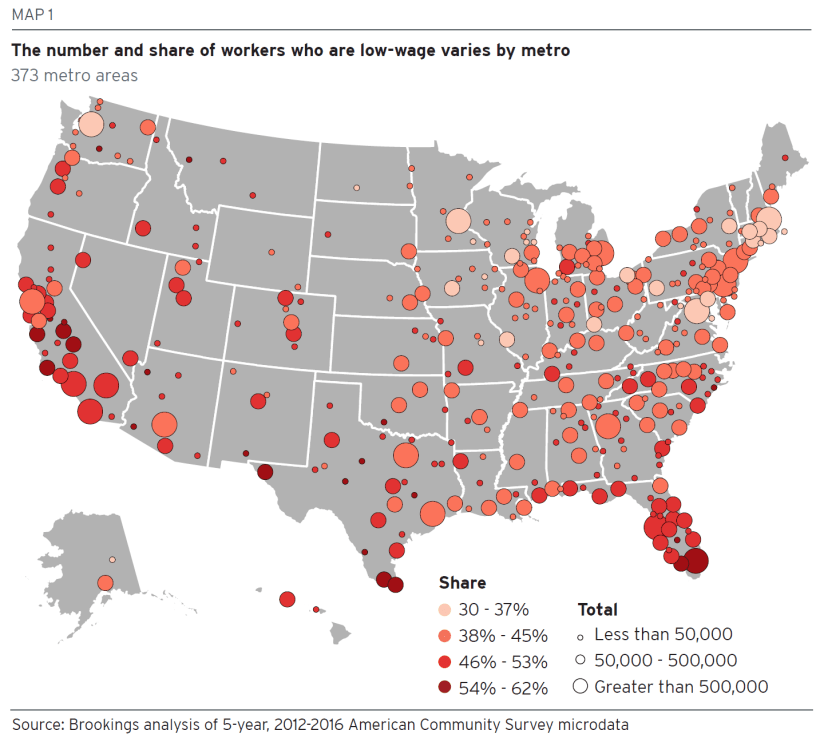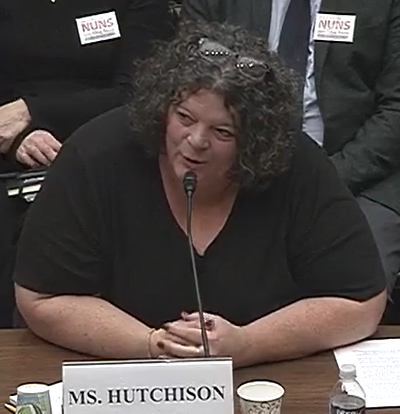
CHN’s State of the Union Response — ‘Mr. President: For Half of Us Americans, Things Are Not So Great’
Editor’s note: the Coalition on Human Needs will hold a webinar on February 13 at 2 p.m. ET to explain what’s in the soon-to-be-released Trump budget. Click here to register.
Yes, Mr. President, unemployment is low. All across our nation, people are working hard when they can. But millions of people do not earn enough to be secure. That is the state of our union President Trump left out of his lengthy address.

Close to half of American workers – 53 million people, or 44 percent – are earning a median hourly wage of $10.22. Their median annual pay is $17,950, because close to half of these low-wage workers don’t work full-time. Sure – many households have two workers, but even at twice that income, it’s pretty tough to make ends meet. Housing, for instance: about half of the households with income of less than $35,000 a year are paying half or more of their income on rent. That doesn’t leave much for all their other expenses.
Of the two-thirds of low-wage workers aged 25-54, 40 percent are raising children. In every region of the country, average child care expenses are either families’ highest expense or a close second to housing. In the South, the region with the lowest costs, child care averages $18,442 and housing averages $17,800. In other regions, those two expenses combined can cost from $2,000 to $12,000 more each year than they do in the South.
Low-income families cannot afford those average costs. That means, despite their work, they are struggling to get by. They are not sharing in the economic growth the President was trumpeting.
In a poll of voters conducted last October for Center for American Progress and Health Care for America Now, more than half (52 percent) reported that they or a member of their immediate family had a serious problem with at least one basic economic need: finding a decent job, having too little money to buy enough food, falling behind on utility or phone bills, going without medical care because of the cost, or falling behind on rent or mortgage.

The President did not talk about Amy Jo Hutchison in his speech. She is a community organizer for WV Healthy Kids and Families/Our Future West Virginia and has two children. She testified at a House Oversight Committee hearing about the Trump Administration’s proposal to lower the current definition of poverty by shrinking its annual inflation adjustment. Her salary puts her above the federal poverty line, but she described the “nights I went to bed hungry so my kids could have seconds.” At her salary, if she rented a three-bedroom house at her area’s going rate of $1,200 a month, she would have $8,000 a year left “to raise 2 kids on.”
Families so close to the edge are less able to save for their children’s education or for their retirement. If they get sick, their financial house of cards may collapse into bankruptcy or even homelessness.
There is immense wealth in this nation. That means we have immense capacity to invest in building more economic security for all Americans now and for the future. That is not what the Trump Administration has chosen to do. Instead, they are adding to the insecurity of at least half of us while enriching millionaires and corporations. This is not just rhetoric: the net worth of the top 1 percent was $34.5 trillion at the end of 2019, more than 20 times the net worth of the bottom half of our population. The Trump tax cuts of 2017 make it worse. By 2027, 83 percent of the tax cuts will go to the top 1%. Fewer than one in a thousand rich families will pay the estate tax because of the tax cuts; it used to be one in 500. Corporate tax revenue dropped by about a third in one year, down about $100 billion.
Those gains at the top have been the priority of the Trump Administration. In the new Trump budget due out February 10, we will see if he continues to target lower-income people with proposals to block workers and families from getting medical care or affordable housing or nutritious food. They have been unrelenting in this regard, seeking drastic cuts in their past budgets. After those were rejected by bipartisan majorities in Congress, the Trump Administration has used regulatory changes to impose cuts on its own.
Trump wants to reverse the progress we’ve made in providing health insurance to millions more people. Much of that has been achieved through the expansion of Medicaid, so he has tried repeatedly to reverse that. He proposed converting Medicaid into a block grant in previous budgets. Now, the Administration is attempting to go around Congress by encouraging states to make an unholy deal: if states agree to a capped block grant, in return they’ll be allowed to serve fewer people, provide them with less care, and/or charge them more even though they can’t afford it.
When it comes to working class Americans, the Trump Administration is increasingly ingenious at coming up with ways to deny them the basics. One recurrent strategy is to make it harder and harder to apply for or renew assistance. Among the shameful examples: Trump wants to put seriously sick people through more frequent disability reviews to qualify for Social Security Disability Insurance benefits. When this was tried during the Reagan years, hundreds of thousands of people lost benefits; a large majority were reinstated but only after months of suffering. The program was abandoned after a surge of outrage, but Trump wants to do it again. They’ve tried to impose frequent work reporting requirements in Medicaid and SNAP/food stamps. Courts have stopped some of this so far. It may sound like these requirements are intended to encourage work. But there are no plans to increase jobs programs or target child care to parents needing to comply, nor is there any recognition that people who are sick or hungry are less likely to keep jobs. It is well known that more paperwork means more people will fall through the cracks and lose the help they need.
 There is no question that African Americans, Latinx, women, and immigrants are especially hurt by the many barriers to help the Trump Administration is ceaselessly erecting. They are disproportionately low-wage workers. But despite the Administration’s us-versus-them strategy, when half of our workers are struggling at low wages, there is more to bring us together than to divide us: 52 percent are white, 25% are Latinx and 15% are African American.
There is no question that African Americans, Latinx, women, and immigrants are especially hurt by the many barriers to help the Trump Administration is ceaselessly erecting. They are disproportionately low-wage workers. But despite the Administration’s us-versus-them strategy, when half of our workers are struggling at low wages, there is more to bring us together than to divide us: 52 percent are white, 25% are Latinx and 15% are African American.
With the trillions rich people and corporations are not paying in taxes, we should be investing in our future: better education, affordable housing, more jobs through a serious effort to rebuild our infrastructure, and further expansion of health coverage. By ensuring that every child is healthy, well-nourished and securely housed, we will help them to succeed in adulthood, and their success is essential for our nation’s future prosperity. None of that can happen if we do not give low-wage workers a better chance to get ahead. The Trump policies are failing them.

